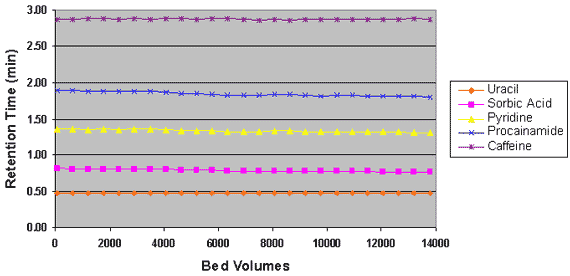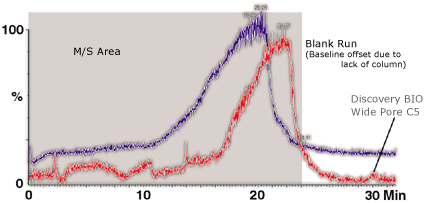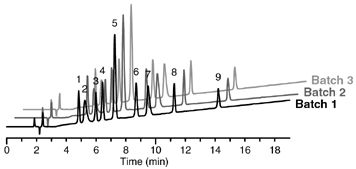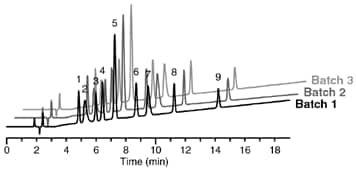Discovery BIO Wide Pore C5
HPLC Columns and Capillaries
| Bonded Phase: | Covalently-bonded pentylsilane (C5), endcapped | |
| Silica: | Spherical, 3 µM, 5 µM and 10 µM diameters, 300Å pore diameter, | |
| high purity (<10ppm metals) |
Solutions for Protein and Peptide Separation Challenges
- Proteomics and biotherapeutics: high efficiency protein and hydrophobic separations
- LC/MS; no-bleed, capillary dimensions, and pH stability
- Protein purification: Scalable from analytical to preparative
- Enhanced lifetime and pH stability over C4 phases
Here's the Proof
Excellent Performance for Large Molecules
Column: Discovery BIO Wide Pore C5, 15cm x 4.6mm, 5µm; Mobile Phase: (A) 0.1% (v/v) TFA in H2O: MeCN (75:25), (B) 0.1% (v/v) TFA in H2O: MeCN (25:75); Flow Rate: 1mL/min; Temp: 30°C; Detection: 220nm; Injection: 10µL; Sample: Protein Test Mix; Gradient: 0-100% B in 25 min.
- RNase (1mg/mL) (13.7kDa)
- Cytochrome C (1mg/mL) (12.4 kDa)
- Lysozyme (1mg/mL) (14.3 kDa)
- Bovine Serum Albumin (2.5mg/mL) (67.0 kDa)
- Myoglobin (1mg/mL) (18.8 kDa)
- Ovalbumin (3.5mg/mL) (45.3 kDa)

Figure 1.Excellent Performance for large molecules
Increased Stability of Discovery Bio Wide Pore C5 Over Conventional C4
After 25,000 column volumes (222 gradient cycles) were passed through the column, the Discovery BIO Wide Pore C5 showed very little change in efficiency. The competitive C4 column showed a significant loss of efficiency, as much as 50%.
Column: Discovery BIO Wide Pore C5, 5cm x 4.6mm, 5 µM; Mobile Phase: (A) 0.1% TFA in H2O : MeCN (95:5), (B) 0.1% TFA in H2O : MeCN (25:75); B 2 mL/min; Temp: 35 °C; Detection: 220nm; Injection: 5 µL; Sample: Protein/Peptide Test Mix; Gradient: 0-20% B in 20 min

Figure 2.Increased stability of discovery bio wide pore
Stability of Discovery Bio Wide Pore C5 at pH 8.0
Retention times of the sample components remained constant after 14,000 bed volumes were passed through the column.
Column: Discovery BIO Wide Pore C5, 5cm x 4.6mm, 5 µM; Mobile Phase: 25mM potassium phosphate, pH 8 : MeOH (95:5); Flow rate: 2 mL/min; Temp: 35 °C; Detection: 254nm

Figure 3.Stability of discover
Undetectable LC/MS Bleed
LC/MS Bleed Analysis on Discovery BIO Wide Pore C5
Column: Discovery BIO Wide Pore C5, 15cm x 4.6mm, 3 µM; Mobile Phase: (A) 0.1% TFA in H2O, (B) 0.1% TFA in MeOH; Flow Rate: 1 mL/min; Temp: 30 °C; Gradient: 0-100% B in 15 min, hold for 5 min, then back to 0% B for 10 min
No TIC baseline rise relative to blank run (gradient run w/o column)

Figure 4.M/S Spectrum (shaded area above)

Figure 5.Essentially no m/z peaks generated from column when compared to blank run. ("X" indicates peaks also found in blank run)
Reproducibility of Discovery Bio Wide Pore C5
Column: Discovery BIO Wide Pore C5, 15cm x 4.6mm, 5 µM; Mobile Phase:(A) 0.1% PFPA (pentaflouropropionic acid) in H2O : MeCN (81:19), (B) 0.1% PFPA in H2O : MeCN (62:38); Flow Rate: 1 mL/min; Temp: 30 °C; Detection: 215nm; Injection: 10 µL; Sample: Peptide Mix (Sigma Cat. No. P2693); Gradient: 0-100% B in 19 min.
Peak Identity: |
Amino Acid Sequence: |
1. Arg8-vassopressin |
CFQNCPRG-amide; disulfide |

Figure 6.Lot to lot reproducible of discovery
Ordering Information

Pour continuer à lire, veuillez vous connecter à votre compte ou en créer un.
Vous n'avez pas de compte ?